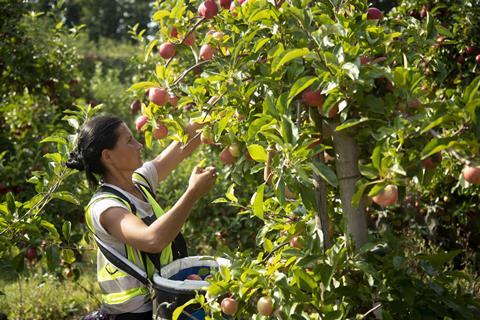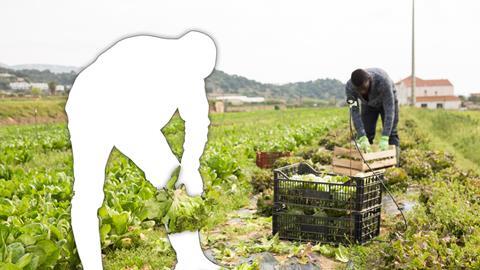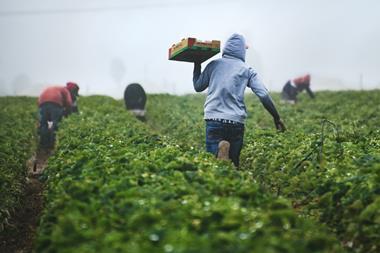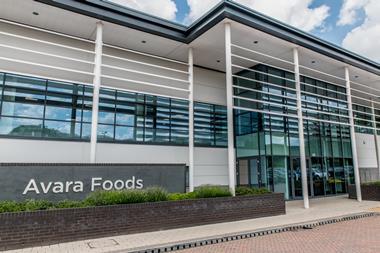In the past two years the food and drink industry’s labour market has been upended. What’s behind the struggle to find staff?
On Barfoots farms in southern England, the first plantings of the year are entering the ground. Tenderstem broccoli and cauliflowers are now in glasshouses in the first stage of a cycle that should culminate in the summer as part of a cornucopia of produce leaving the farmgate. This year, however, Julian Marks, Barfoots group MD, fears the vegetables may never leave the ground.
Like many farms across the UK, Barfoots is suffering acute labour shortages. In 2020, it lost about 15% of its seasonal staff, and fears the same (or worse) could happen this year. Barfoots was forced to throw away more than 700 tonnes of courgettes last summer due to a lack of workers, as well as sizeable volumes of green beans and sweetcorn. Many growers suffered similar fates and a recent survey by the British Growers Association revealed that vegetable plantings are down by a third this year for fear of a repeat performance.
Barfoots is so far mitigating the shortfalls by giving workers more hours with many employees now doing up to 70 hours per week, says Marks. While they are happy to do so in order to earn more money, such a model is not entirely sustainable for the long run.
Britain’s food and drink labour shortage: in numbers
The problem at Barfoots is caused by a lack of seasonal workers, typically from eastern Europe. But a similar problem is hampering businesses in need of permanent staff as well. Around 290,000 full-time workers have left the sector since the start of the pandemic, according to exclusive ONS data provided to The Grocer. The data for the first time reveals the full impact of the past two years on the industry’s labour force. While the losses are significant, this does not account for the impact of furlough ending at the end of September as official data for this period is not yet available. Omicron has only heightened fears that furlough’s end could cause another wave of unemployment, particularly among hospitality workers.
“Fundamentally these people are fed up with working in that environment”
The issue of labour shortages is both pressing and pertinent, attracting attention at the highest echelons of government. Dave Lewis, former Tesco CEO, was hired by Boris Johnson in October as his official supply chains advisor with a major part of his role to carry out a “deep dive into the evolving UK labour force”. Lewis’s tenure is now up, and the report, delivered just before Christmas, has not been published, though a note of thanks to his advisors (seen by The Grocer) alluded to medium and long-term steps that he had identified, as well as the immediate focus of “saving” Christmas. But beyond a Christmas Eve pledge by the Home Office to extend the seasonal workers scheme at the current 30,000 visas – with the potential to increase by 10,000 if necessary – while also including ornamental plant growers in the scheme, it is unclear if, or how, the PM will respond.
But the labour shortages aren’t just about seasonal workers. And importantly they’re not just caused by Brexit and Covid as the ONS data shows. True, the pandemic caused many European workers to return home, while post-Brexit immigration changes removed the rights of many EU workers to freely live and work in the UK. The data shows hospitality and farming is suffering most. But the surprise is that this is as much a product of a British worker exodus as a European one. Around 60% of the workers who left the industry since before the pandemic are British, a proportion that rises to over 80% for permanent farming staff.
Also surprising is that the vast majority of lost workers are still of working age, the data shows, therefore suggesting that “fundamentally these people are fed up with working in that environment,” according to Jonathan Kittow, director of Simply Supply Chain. “Some will be moving from farms to factories and warehousing if they think it’s a better environment with more pay. If you’re working a manual labour job then often you’re less interested in where you are if it pays a bit more and the conditions are slightly better.”
Food manufacturing, by contrast to farming, has suffered considerably less from a worker exodus. While many thousands of workers have clearly left, in some areas, like drinks manufacturing, there have been significant influxes of new workers.
It is important to note these numbers are only permanent employees, and do not include seasonal workers on temporary visa schemes. It is with workers like these that the likes of Barfoots are suffering most.
Barfoots’ labour force has already undergone significant shifts in recent years, from being predominantly comprised of Poles to more Romanians and Bulgarians, a shift driven by evolving economic conditions in Poland that have made the UK a relatively less attractive destination, says Marks. But since last year, the challenge has been one largely of returnees. While Barfoots typically expects around 70% of seasonal workers to return each year, this dropped to 40% in 2021. “A lot of your skills are not coming back and so it takes longer to get up to the productivity levels you require,” says Marks.

Temporary visas
The UK government’s temporary visas were supposed to help. Launched at the end of 2020 for the coming year, the Home Office issued 30,000 seasonal visas for fruit & veg growers to try and help find the workers they would need for the annual harvests. Many farming groups decried the number as not enough, but the latest Home Office figures from the end of September 2021 show the scheme is not oversubscribed, with 24,661 visas taken up. Kevin Foster, immigration minister, told an Efra committee last month that despite criticisms, the 30,000 is not “an arbitrary cap. We haven’t hit it and we won’t hit it.” In response, Dave Doogan MP replied that the “policies are difficult and last minute. That’s why they’re not exhausted.”
Much of the debate and friction over seasonal visas stems from the fact there are no agreed metrics for the size of the seasonal workforce and therefore the number of visas required. While the UK was in the EU, free movement meant the numbers were barely monitored and while the Home Office has now published figures for last year, they still lack any useful detail. Precise information – such as a breakdown by region and sector, how long someone might be needed on a daffodil farm compared with a cauliflower farm, how many workers come to the UK for the allowed six months, how many work just at one farm and how many move around – is lacking. Without it, it is very difficult to build an evidence-based model for a visa scheme that all parties can buy into, says David Camp, CEO of the Association of Labour Providers. Camp is therefore among those pushing for an open and transparent data collection co-ordinated between government and industry.
Despite government schemes to help them in the run up to Christmas, many UK meat and poultry processors are suffering acutely due to labour issues. The government granted 5,500 temporary visas for poultry workers and 800 for butchers last year, but smaller producers in particular are still struggling to find staff. Philip Hunter at Suffolk Turkeys rears and processes about 10,000 birds each year on his site near Eye but lost about half of his local seasonal labour to “better, full-time jobs”. Some went to the nearby Cranswick poultry plant, others into construction, while about half of his Romanian contingent also went elsewhere. It was, he says, “a complete nightmare”.
The departure of Europeans in the meat sector continues to garner most headlines, but just like at Suffolk Turkeys, the loss of British workers is often just as damaging. Animal production in the UK has lost about 36,000 workers in recent years, according to ONS, more than 90% of whom are British. In meat processing, meanwhile, about 26,000 have left: a 40:60 split of Brits to Europeans. The British Meat Processors Association estimates this has left a vacancy rate of about 15%, with about 65% of those in butchery roles.
What should cause alarm across both farms and processors is the proportion of those aged 45 and 54 leaving the workforce. Early retirements grew significantly through the course of the pandemic with the Bank of England flagging it as a risk factor in the UK’s economic recovery from the pandemic.
Both farming and processing are already ageing workforces. In processing, about one-in-five workers are due to hit retirement age in the next 10 years, while on farms the rate is even higher. If they cannot therefore find a way to make themselves more attractive to younger generations then the future is dark.
“We really need time to adjust. That is all we are asking for”
This will be no simple feat. More 25 to 34-year-olds left the food industry during the pandemic than any other age group, led in part by an “anti work” movement that encourages followers to work as little as possible in traditional jobs to prioritise leisure time. Many now suggest the popularity of the trend signals a long-term shift in preferences and lifestyles among younger generations, with Goldman Sachs warning it poses a “long-run risk” to labour force participation.
How businesses respond and adapt is therefore crucial. Avara is offering more flexible working hours for those who can’t work standard shift patterns, alongside bumping its pay packet to a minimum of £10 an hour, retention bonuses, and pay rises for certain skills. Pilgrim’s UK is trying to tap into alternative labour pools such as ex-military personnel, the long-term unemployed, and ex-offenders – a policy seemingly in line with the Home Office’s message to “make the work attractive to domestic workers rather than rely on cheap labour from abroad”.
They are not alone. Many in the meat industry claim they are on board with the government policy, they simply need more time to make it happen. But according to Bob Carnell, CEO of ABP Food Group, the government is failing to engage with these calls. “We really need time to adjust,” he says. “That is all we are asking for: to redefine the business model to allow us to move forward.”
It is all part of the search for a new status quo in the post-Brexit, post-Covid age. A status quo that will inevitable be found eventually. But with shifting worker priorities, reduced migration, and an ageing workforce all having an effect, it could be a long and bumpy road. Many businesses are simply left wondering what the cost will be along the way.




















No comments yet